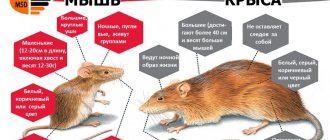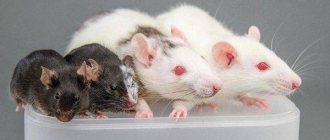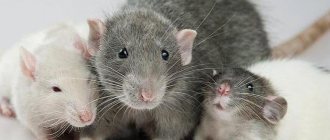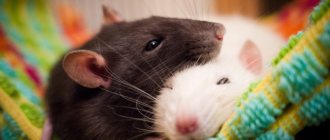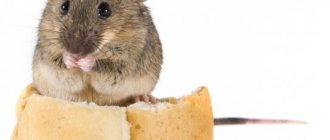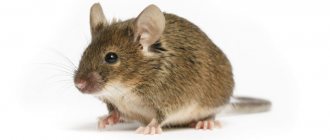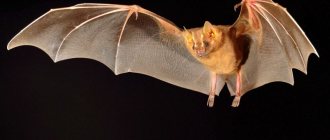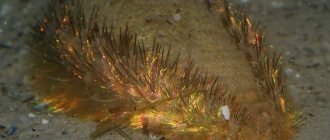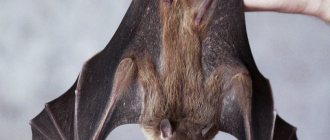Many people living in private homes are interested in the difference between a mouse and a rat. The point is not that both of them carry various infections, but that one should begin to fight rodents by determining their type. Thanks to this, it will be possible to choose an effective way to destroy them. To understand the differences between a mouse and a rat, you should know the structural features of the body of these similar animals.
Many people living in private homes are interested in the difference between a mouse and a rat.
External differences
The main signs of differences between rats and mice can be observed in external characteristics. First of all, they are clearly visible in the mass of animals, as well as in the structure of the body. Based on them, you can easily determine which representative of the rodent family is in front of you.
Dimensions
The most significant difference between rodents is determined by size. Rats have significantly larger dimensions and a stocky body. The length of an adult can reach 30 cm, not counting the tail. At the same time, weight indicators fluctuate between 600–700 g. A mouse is a smaller rodent. It rarely grows more than 10 cm in length, and its weight does not exceed 30 g.
Tail
It is also not difficult to distinguish animals by the characteristics of the tail. In rats, it looks more massive, thick, has an impressive length, which is sometimes not inferior to the length of the main body, and sometimes exceeds it, reaching up to 35 cm. The tail is bald or bristly, depending on the species. In small rodents, the length of the tail ranges from 4 to 6 cm, almost all over it is covered with small hairs.
Find out also what to feed and how to care for a decorative rat.
Head
The shape of the head of a rat and a mouse also has significant differences. The former has a more elongated, pointed muzzle. The organs of vision are poorly developed. Small black or red eyes are deep-set and have a small viewing angle, so the animals have to constantly turn their heads to examine their surroundings. It is interesting that they see it in gray tones, and red objects are transformed into black.
In mice, the shape of the head is more rounded, flattened, and its size is much smaller. But the eyes, compared to the size of the muzzle, are large, convex, and expressive. The animal has developed farsightedness.
Important! Both types of rodents have teeth that grow throughout their lives, so they need to be given hard objects to chew on that can wear down their incisors.
Paws
There are practically no calluses on the rat's paws, which are necessary for climbing. But there are movable fingers with sharp claws. Thanks to this property, rodents can move freely through trees. Sometimes they make homes for themselves in abandoned hollows. The excellent muscularity of the paws allows rodents to jump long distances. Another advantage of the limbs is the presence of membranes between the fingers, which are similar in appearance to folds of skin.
They make rats excellent swimmers, capable of obtaining food in a body of water. When moving along a horizontal surface, the paws of rodents are widely spread. If you manage to examine the footprint, you will notice that the angle between the outer phalanges is about 180°. Since the predator often moves by jumping, the distance between the tracks can also be impressive.
You may find it useful to know what types of domestic rodents there are.
The legs of mice are short. Each of them has 5 tenacious fingers, so these small rodents are able to move through trees. However, their limbs are not as powerful as those of rats. They move mainly in mincing steps, with the toes spread minimally, and the distance between the tracks is about 1 cm.
Wool
Mice have softer, more delicate fur. In nature, its predominant color is brownish-gray or ash-gray, but it can vary depending on the environment. For example, desert mice have a yellow-sandy coat color, and among decorative species there are white, black, gray-blue, and variegated tones.
Did you know? Mice keep their homes clean and tidy, and with droppings they mark routes to food sources.
Rats have thicker, longer, and coarser fur. The most common colors are gray and dark brown. In individuals bred as decorative domesticated animals, many other shades are found: white, gray, reddish, spotted, etc.
Ears
The rat's ears are straight, even, pointed towards the top.] Hearing is very well developed - the animal perceives sounds with a frequency of up to 40 kHz, while humans - up to 20 kHz. In mice, this figure is even higher - animals perceive sounds with a frequency of up to 100 kHz, although the hearing organs themselves are small, rounded, rolled up.
Types of mice
There are about 300 of their representatives. Some of them are decorative and are specially selected for home maintenance. These, for example, include tiny mice with a body length of about 7 cm. These rodents are brightly colored. At the same time, the juveniles have brownish, dull fur. After the first molt occurs, the rodents become bright red. They are kept in spacious cages and must be fed invertebrates, grains and greens.
The largest mouse is the Asia Minor mouse, reaching 13 cm. It is mainly found in Asia, Georgia in mountainous areas.
In the central regions, the field mouse is mainly widespread, which rarely settles in human buildings. Her tail is a quarter less than her body length. The color is reddish-brown on the sides, with a black stripe running down the center of the back. However, coloration for rodents is not one of the main characteristics by which they can be distinguished, since it differs somewhat by region, and due to their migration, it can change beyond recognition.
The most common taxonomic unit that inhabits homes is the house mouse. This type of mouse is characterized by the fact that their length reaches 10 cm, the tail can be the same length as the body length, or be half of it. During its existence with humans, it has adapted to its food, eating plant and partly animal products that humans consume. In the summer they can go to the fields, where they feed on grain, and with the arrival of autumn they move to human habitation.
Also, wood mice can settle in houses during autumn migration.
Differences in behavior
Both rodents are capable of causing enormous harm to humans. Not only do they brazenly eat food supplies, they also bite a lot of things on their way, rendering not only food unusable, but also household items, clothes, and shoes. They are carriers of serious diseases and infections dangerous to humans. It is difficult to get rid of mice and rats, since both types of rodents are unpretentious and can live in various conditions - in cold basements, hot boiler rooms, etc.
Did you know? It has long been believed that of all the creatures on the planet, only humans can laugh, but American scientists have proven that rats, who also have a sense of humor, also have this ability.
The speed that running animals are capable of developing is quite high in relation to their size. Mice move faster, moving at speeds of up to 13 km/h. Rats are slightly inferior to them in “sprinting”. The maximum speed developed by gray “robbers” is 10 km/h, but at the same time they are able to jump over obstacles up to 80 cm high and make long flight jumps at a distance of up to 1 m. Both mice and rats are able to fit into very small holes and hold on perfectly on the water.
There are some differences in the lifestyle of these two types of rodents. Mice in nature live in colonies with a clearly expressed hierarchical structure. However, they obtain food individually, and therefore feed mainly on “harmless” food, rarely attacking insects that they are able to overcome on their own. The animals are quite shy and cautious.
Rats hunt more often in packs and are more aggressive. In a group, they may well attack a mammal that is larger than them. When danger approaches, they show incredible courage, and in self-defense they can even attack a person. There is also a difference in the activity of the animals. Mice sleep much more often, plunging into the “kingdom of Morpheus” about 15 times a day. Moreover, their sleep is short, and each period of activity lasts 30–60 minutes. Rats, as a rule, sleep once a day.
Familiarize yourself with the behavior, care and nutrition of rats at home.
Who's smarter
The rat is one of the smartest animals. She has a highly developed intellect, thanks to which, according to scientists, she is able to analyze information. Animals easily adopt the experience of their ancestors and, as far as possible, do not repeat their mistakes. If a rodent falls into a trap, it will signal danger to other members of the pack, who will try to leave the area. Rats are trainable and can be taught to perform a lot of tricks.
Mice are not inferior in brain size to body size, but in an intellectual battle they will definitely lose to rats. They are extremely difficult to train, although sometimes they get used to their name and respond to it. They remember routes leading to food sources and are able to stock up based on their instincts. Otherwise, their mental abilities are much weaker.
What is the difference between a rat and a mouse
Despite the similarities between these rodents, they differ greatly from each other:
The main differences are due to the different number of chromosomes. In rats there are 22 of them, and in mice 20. Therefore, it is impossible to cross these mammals in order to produce offspring. Decorative rats reach 30 centimeters in length excluding the tail. Mice do not grow more than 9 and a half centimeters. Large rodents weigh up to 650 grams. A mouse cannot be heavier than 30 grams. Despite the fact that the number of newborn rat and mouse pups per female varies from 5 to 12, the number of nipples in rodents varies. A rat has 12 of them, while a mouse has fewer nipples - only 10. Due to their fast metabolism, the activity of mice differs from rats in being polyphasic. The animal falls asleep 15-20 times per day. Each activity phase lasts from 25 minutes to one and a half hours. The rat lives more “slowly”: it sleeps once a day if it is not disturbed. There is a difference between them in nutrition. Although both of these species are omnivores and can attack and eat other living creatures, the rat’s predatory instinct is more developed. Mice are seed eaters. Predatory instincts appear only when absolutely necessary, which is why they are even considered vegetarians.
Rodent hunters
A rat differs from a mouse in being more aggressive. When danger approaches, they show miracles of courage and can even attack a person in defense. In nature, rats often hunt in packs. Animals in groups can even attack mammals larger than themselves.
Mice prefer to hunt alone. Therefore, only insects and smaller animals become their victims. These animals are shy and extremely careful.
Due to such character traits, these animals are natural enemies. Large rodents attack small ones, kill them, and may even eat them. Therefore, the instinct of self-preservation dictates that mice beware of their larger relatives. Smelling the smell of a rat, small rodents leave their habitat.
For the same reason, individuals of these two species cannot be kept together. It is not even recommended to place cages with them in the same room.
Comparison of rodent intelligence
Rats are smarter and smarter than their smaller counterparts. Catching a wild specimen is a troublesome task. They are careful, attentive, cunning. If the loser suddenly falls into a trap, she lets the rest of the colony know about the danger. Never again will any animal appear here.
There are many stories about how these clever thieves opened bottles of wine, closed with plastic caps, one of them put the tail into the neck, pulled it out, and others licked the delicacy from it.
Or how rodents, climbing over a wide crevice, stuck together in a path, biting the tail of the animal in front with their teeth. Using such a living bridge, the entire colony easily crossed the obstacle.
Companion rats, living next to humans, also show their remarkable abilities. They are easy to train, respond to names, and even come up with their own games, inviting the owner to join.
There are no similar stories about mice. However, these sweetest creatures can give their owners a lot of pleasant moments of communication. They also become attached to a person and touch those who watch their lives with their habits.
Who grows faster: a mouse or a rat?
The metabolism of mice is higher than that of rats, so their lifespan is shorter. The average lifespan of small rodents when kept at home is 1.5-2 years, while their large relatives live up to 2-3 years.
Rats and mice grow the same way. At the age of 1-1.5 months, young rodents are capable of reproducing their own offspring.
Rat tails are longer than mice's. They are equal in size to 70-110% of the body. Mouse tails are shorter. They can reach no more than 60% of the body; the tails of large rodents are thicker than those of mice and more powerful (with the exception of the tailless rat); rats' faces are sharper and more elongated. Mouse heads are rounder and less pointed; The body of small rodents is more round. The animals rarely straighten up, preferring to sit huddled together in a ball. And their species relatives can rest, lying on their tummy, with their hind legs stretched out, like cats; mouse fur is soft and silky, while rat hair resembles coarse hair; The hearing organs of rodents are structured differently. Mouse ears are thinner and rounded. They resemble petals rolled up into a ball. Rat ears are thicker, sharper, and not curled.
Life expectancy difference
Mice live very little in the wild and at home - their average lifespan is 1.5–2 years. Despite this, the colonies of these animals grow quite quickly, since rodents are able to give birth to offspring already at the age of 8–9 weeks. Moreover, additions to the family can occur up to 10 times a year.
You will be interested to know how many years decorative house mice live.
The lifespan of rats is longer - up to 3 years. They also become “parents” quite early, reproducing up to 12 members of the offspring at a time.
How are rodents harmful?
Rats are pests. The very rapid reproduction of rats causes serious damage to both farmers and villagers, and residents of the metropolis. Here's why rats are dangerous in the country:
- carry severe infectious diseases: plague, tuberculosis, brucellosis, leprosy, rabies, typhus, hepatitis, etc.;
- these animals destroy food products in warehouses and factories;
- eat feed from farm animals and birds;
- chew floors and walls of premises;
- damage electrical cables and various devices;
- contaminate food products with helminths and salmonella.
Rats adapt well to any conditions, and they are very tenacious. These animals cause a lot of inconvenience to people and carry dangerous diseases, so it is necessary to get rid of them without pity in all possible ways.
Differences in nutrition
In the warm spring-summer period in the natural environment, the mouse prefers to eat plant seeds and cereals. Field animals feast on wheat, buckwheat, and oats. Rodents living in forests prefer hazel nuts, acorns, and can even feed on small insects. Near reservoirs they find roots and stems of plants, berries, and larvae.
With the arrival of autumn cold weather, the mouse begins to actively look for warm places to eat, moving closer to humans. Penetrating into a home, it becomes omnivorous. In addition to any edible food, she will not disdain such products as soap or candles. Animals cause particular harm to stocks of vegetables stored in the basement, to cereals in bags, they can chew wires, and inhabit shelves with linen and clothes.
Important! Ornamental rodents should not be given raw meat, lard and smoked meats.
Rats bring even more trouble. These rodents are capable of causing damage to anything in their path, including wires and structures. Everything that humans eat suits them perfectly. Under natural conditions, rats need food high in protein, feeding on fish, amphibians, and insectivores. By nature they are predators, they destroy bird nests, and can eat small rodents, including mice.
At home, a large rodent eats any food products and waste, and does not disdain feed intended for livestock and poultry. The rat does not store supplies, but without food it dies quite quickly, after 3–4 days. Her diet must contain water or food containing a lot of moisture. Without receiving it, the rats die within a few days. As for domesticated ornamental species of rodents, it is recommended to feed them with grain feed and vegetables. Protein foods are served in the form of boiled chicken, egg whites, and cottage cheese.
Read how to properly bathe a rat at home.
Intelligence of Rats and Mice: Key Differences
Rats have more developed intelligence than mice (this also applies to domesticated rats and mice). But this does not mean at all that a mouse is a bad pet. Decorative rats are very smart animals that quickly make contact, and they also quickly become attached to their owner. They are trainable and can express their affection and love. In addition, the decorative domesticated rat knows and responds to its name when it is called to itself, especially if the owner offers some kind of delicacy or fun activity.
Essentially, the intelligence of a pet rat can be compared to that of other pets (cats and dogs). Rats are sociable animals that respond well to people, as evidenced by their love of games. According to many owners of pet rodents, the latter can even come up with their own entertainment and games, subsequently willingly demonstrating them to their owners, inviting them to join in the fun.
What do newborn rats and mice look like?
Like all cubs, pups and mice have an attractive, funny appearance. Watching these harmless little lumps is pure tenderness. At first glance, they seem very similar, but upon closer examination, significant differences in appearance are clearly visible. First of all, you need to know that a newborn rat has a body length of about 3 cm, while it is completely naked, without any signs of fur. A mouse that has reached this length already has a fluffy coat.
Differences that are mostly similar to those present in adults:
- the mouse's body is more rounded. The animal prefers to sit huddled into a ball. Rats have a more elongated body, and they often like to rest stretched out, like cats;
- the tail of a large rodent is more powerful, occupying about 80% of the body length, while that of a small rodent is thin, barely more than 50%;
- The baby rat's muzzle is pointed and oblong. The hearing organs also have the same features. Mice have shorter and rounder heads, thin, rounded ears.
How to determine the type of spoiled food
You can also distinguish a mouse from a rat by the type of spoiled food.
If there are rodents in the house, you can determine their species according to the following behavioral characteristics:
- Cereals. When eating cereals, rats consume the grains without leaving any traces behind. Mice leave behind husks and spoiled grains.
- Small representatives of the family prefer to eat in only one place, while large ones cause serious damage to the household and food supplies, choosing new food sources each time.
If rodents have settled in the house, it is important to be able to determine their species, since control methods differ. To exterminate mice, you need to choose a trap or insecticides; to remove large rodents, you need to call professional exterminators, since these animals are extremely careful, cunning, and smart.
Source
Life cycle
On average, ordinary gray rats live about 3-5 years. Larger black individuals are 4-6 years old. The lifespan of mice is 3 years. Both are extremely fertile, and the family is growing by leaps and bounds.
Pregnancy in rats proceeds very quickly - about 24 days, and in mice about 18. There are more than 10 individuals in one litter. There may be 7-10 cases of pregnancy per year. So they gain numbers with amazing speed, especially in favorable conditions: a good climate and constant access to food.
Reasons for incompatibility
As mentioned above, these rodents do not interbreed. In addition, these animals are natural enemies. It's no secret that a rat destroys caught prey (a mouse), but can also eat it if there is no danger. If an adult rat gets into a place inhabited by mice, then, most likely, the latter will be killed or expelled in a fairly short period of time. Note that the very presence of rats in a place where there is a concentration of mice leads to great concern for them.
This is explained by the fact that, according to some data, mice can detect the smell of rats, which for them is the smell of danger. It is for this reason that pets of different species should not be in the same cage.
Therefore, it is important to know how mice differ from rats; the signs are extremely significant. After all, if you decide to have such pets, then it is better to keep them away from each other, in separate cages located in different rooms
Paws
In mice, they are small and have tenacious claws, thanks to which the pest can easily run along vertical surfaces.
Rats have strong and muscular limbs. The hind legs are longer than the front ones, which allows the animals to move by jumping. The fingers have membranes called leathery folds.
Head
Rats' ears are small and triangular. They are pressed to the head. Mice have large pink ears that are wide at the base.
The eyeballs of rats are small. Norushkas have large and expressive eyes.
Wool
The mouse feels silky and pleasant to the touch. And her relative has hard and coarse “hair”. The cover of an adult resembles a hard pile. Fur does not cover a rat's tail. Rat and mouse
